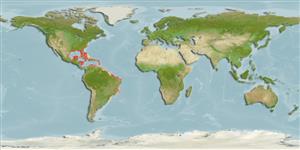Common names from other countries
Classification / Names / Names
Common names | Synonyms | Catalog of Fishes (gen., sp.) | ITIS | CoL | WoRMS
Environment: milieu / climate zone / depth range / distribution range
Ecology
Benthic; depth range 0 - 49 m (Ref. 2022). Tropical
Western Central Atlantic: USA, Colombia, Bermuda and the West Indies.
Length at first maturity / Size / Weight / Age
Maturity: Lm ? range ? - ? cm Max length : 2.5 cm TL male/unsexed; (Ref. 281)
Valves color: Brownish red to buff with darker mottlings and speckles. Surface of valves: Glossy. Lateral area: Separated from the smooth central area by a strong, rounded rib. Central area: Peppering of black eyes. Girdle: appears naked, leathery and brownish to flesh colored (Ref. 281).
Maximum depth from Ref. 110502.
Life cycle and mating behavior
Maturity | Reproduction | Spawning | Eggs | Fecundity | Larvae
Members of the class Polyplacophora are mostly gonochoric. Life cycle: Eggs hatch into lecitotrophic planktonic trocophore larvae (no veliger stage) which later metamorphose and settle on the bottom as young adults.
Burghardt, G. and L. Burghardt. 2006. (Ref. 281)
IUCN Red List Status (Ref. 130435: Version 2024-1)
CITES status (Ref. 108899)
Not Evaluated
Not Evaluated
Human uses
| FishSource |
Tools
More information
Age/SizeGrowthLength-weightLength-lengthMorphologyLarvaeAbundance
Internet sources
Estimates based on models
Preferred temperature
(Ref.
115969): 23.5 - 28, mean 26.5 (based on 222 cells).
Vulnerability
Low vulnerability (10 of 100).
Price category
Unknown.
